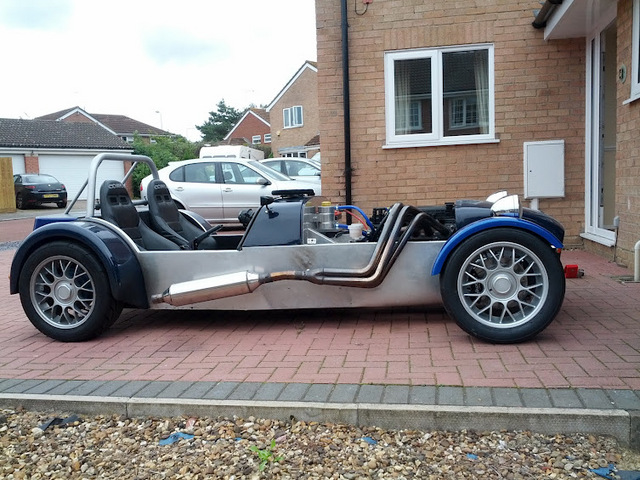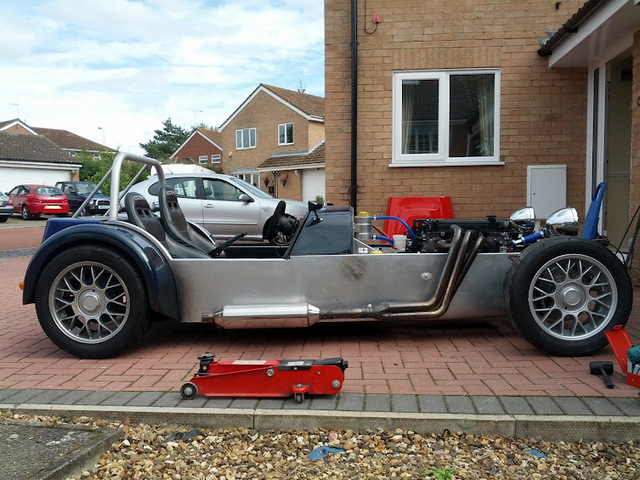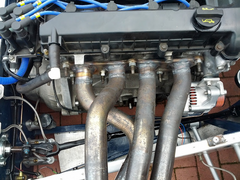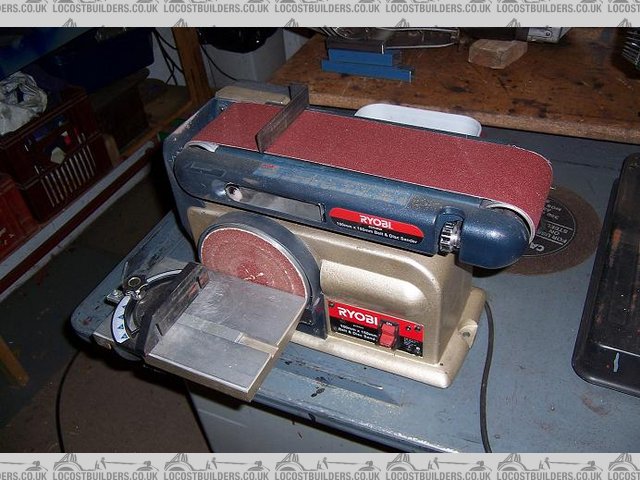
Duratec Exhaust woes
redeye - 13/9/12 at 12:58 PM
Hi all
Ive been having trouble getting my old pinto exhaust converted to fit my Duratec
I bought an exhaust flange from Fastdan on here, which was perfect quality.
I cut the old flange off and had the exhaust welding by a professional since its stainless steel (I didnt fancy my own skills for this)
The welding job top notch, but the exhaust was in the wrong place, anyway to cut a long story short, after two attempts br the pro (very hard to get
it right when he didnt have the car to work with) I ended up calling out a mobile welder who could tackle the job whilst on the car.
everything is welded up nicely now and in the correct position
Unfortunately however, the stainless flange has warped slightly with the amount of welding its had to sustain.
Ive fitted the exhaust which was very tight, and now have a slight gap, less then 1/2 a mm between the flange and engine face.
The mobile welder fella says he has a machine that should be able to straighten it a bit, and then its could be sanded down
I forget the name of the machine that he said he would use (any ideas?)
Id like to book the car in for a rolling road asap but obvioulsy need to sort this problem out first.
Does anyone have a suggestions as how I myt sort it so I can get the rolling road done, then maybe have it fixed properly later?
I was thinking of using some exhaust filler, or maybe some sort of silicon sealent?
Would these work with this problem
Your help is greatly appreciated.
heres some pics of the handy work


Description
Before


Description
After (much better)


Description
It seems to be leaking from ports 2 and 3
loggyboy - 13/9/12 at 01:08 PM
Machine shop should be able to skim the mounting face for small charge.
owelly - 13/9/12 at 01:17 PM
1/2 a mm? The exhaust gasket should take that up or try adding a bit of exhaust paste.
To get the flange flat, I would draw file it (checking it with engineers blue and a flat surface) but I don't like paying folks to do stuff!!!
Would splitting the flange between cylinders 3 and 4 help?
ashg - 13/9/12 at 01:20 PM
heat it up with the engine and a blow torch it might move back if your lucky. failing that staple a sheet of high grit emry to the work bench and rub
it back and forth on that.
snapper - 13/9/12 at 01:36 PM
My Pinto exhaust has 4 seperate flanges makes it easier to pull them flat one at a time.
redeye - 13/9/12 at 01:43 PM
Some very helpful advice...thanks guys
The machine the guy mentioned was a fly press,
there's an engineering firm around the corner from work so Ill take it there for them to have a look at it.
In the mean time Im thinking about using this
http://www.halfords.com/webapp/wcs/stores/servlet/product_storeId_10001_catalogId_10151_categoryId_255217_productId_173106_langId_-1?cm_mmc=Shopping-_
-Google%20Product%20Search-_-Car%20Care%20%26%20Maintenance%2FCar%20Parts%20%26%20Spares%2FHead%20Gasket%20%26%20Exhaust%20Repairs-_-Loctite%205910%20
Premium%20Silicone%20Black%20Gasket%20Maker%2FSealant&source=shopping
splitting the flange wouldnt help a great deal I dont think due to the position of the flange bolts, Caterhams exhaust is similar to this with four
seperate flanges, but I think it would make the problem worse.
Rolling road is booked for thursday and I can take it to the engineers on monday so we'll see how it goes.
If a try the sealent over the weekend and it cures it, i may just use that.
cheers for the help guys 
twybrow - 13/9/12 at 01:43 PM
Was the process/machine a lapping machine? The problem with a stainless falnge/zorst is that thay are quite a challenge to bend/alter them by brute
force alone. You may well find that some heat would do it, along with gradually increasing the torque on the exhaist studs to close up the gap, but
you risk stripping the stud from the head.
Could you buy another flange, and bolt the new flange to te engine, then offer up the zorst, slide it into position. Then do up the nuts, meaning you
gap should be very obvious, and easier to get to. Then just weld up that gap. You could even use your welder at home to tack the two pieces togeth
in-situ, then take the whole assembly to a welder to fully weld up... I appreciate it would add a bit of weight, but it might be easier and cheaper
than than paying machine shops to skim the existing plate...
twybrow - 13/9/12 at 01:47 PM
quote:
Originally posted by redeye
In the mean time Im thinking about using this
http://www.halfords.com/webapp/wcs/stores/servlet/product_storeId_10001_catalogId_10151_categoryId_255217_productId_173106_langId_-1?cm_mmc=Shopping-_
-Google%20Product%20Search-_-Car%20Care%20%26%20Maintenance%2FCar%20Parts%20%26%20Spares%2FHead%20Gasket%20%26%20Exhaust%20Repairs-_-Loctite%205910%20
Premium%20Silicone%20Black%20Gasket%20Maker%2FSealant&source=shopping
Working link!
That wont take the temperature of an exhaust. Look for some exhaust sealing paste instead.
redeye - 13/9/12 at 01:54 PM
thanks
how about this stuff then?
Link
FASTdan - 13/9/12 at 02:13 PM
Hi,
A skilled fabricator with an Oxy torch can sort this for you. Fast application of concentrated heat on the back face (opposing where the welds are
that are causing the distortion) will have the reverse effect and bring the plate back in line.
This seems especially effective on stainless - I watched a guy do it to one of my early stainless manifolds and was gobsmacked at how well it worked,
he applied heat, then flipped it over onto the flat bench and we literally watched it pull back on its own. reckon he got it back to less than 0.5mm
all over (free, not bolted down).
Might be a simpler option than trying to set it up on a press if you can find someone with the skill. Blow torches etc wont apply heat quickly
enough.
I'm assuming your 0.5mm is when bolted up? so probably 1-2mm when not pulled down? So if you can bring it back to within 0.5mm without pre-load
it should be ok when tightened back up.
redeye - 13/9/12 at 02:17 PM
quote:
A skilled fabricator with an Oxy torch can sort this for you. Fast application of concentrated heat on the back face (opposing where the welds are
that are causing the distortion) will have the reverse effect and bring the plate back in line. This seems especially effective on stainless - I
watched a guy do it to one of my early stainless manifolds and was gobsmacked at how well it worked, he applied heat, then flipped it over onto the
flat bench and we literally watched it pull back on its own. reckon he got it back to less than 0.5mm all over (free, not bolted down). Might be a
simpler option than trying to set it up on a press if you can find someone with the skill. Blow torches etc wont apply heat quickly enough. I'm
assuming your 0.5mm is when bolted up? so probably 1-2mm when not pulled down? So if you can bring it back to within 0.5mm without pre-load it should
be ok when tightened back up.
Yeah its at least 1-2mm out when not bolted up. I like the sound of the method you mention but Im not sure of anyone local with this skill? Ill try
ringing a couple of places and mention this to them and see what they say.
Thanks
FASTdan - 13/9/12 at 02:39 PM
Thats the problem - the guy in question was often asked to 'work his black magic' by the supervisors on various components that would come
into the assembly shop warped or bent from welding or poor machining. It struck me it was a bit of an art form - I subsiquently tried myself with some
success but not as accurate as he could do it, think I was too cautious in applying heat.
redeye - 13/9/12 at 02:49 PM
Where does this almighty magical wizard reside?

FuryRebuild - 13/9/12 at 02:59 PM
It always amazes me how much stainless can warp. You have my sympathies.
dhutch - 13/9/12 at 03:19 PM
How big is the mating face on duratec? Get some bathroom sealant on it...
redeye - 13/9/12 at 03:20 PM
quote:
How big is the mating face on duratec? Get some bathroom sealant on it...
bathroom sealant? care to elaborate? surely this would burn off after a while?
v8james - 13/9/12 at 03:21 PM
Would sealant not kill the lambda sensor?
redeye - 13/9/12 at 03:25 PM
quote:
Would sealant not kill the lambda sensor?
I thought that too
but I dont actually have a lambda sensor
owelly - 13/9/12 at 03:51 PM
In my bike racing days when changing exhausts, cylinders, heads, pistons etc was a routine occurrance, I always used cheap silicon sealer to seal the
down-pipes. I was often told it wouldn't work or the fumes would kill me and anyone within a 5 mile radius but it worked and was easy to clean
off ready for the next application!
redeye - 13/9/12 at 03:57 PM
I have some good rtv silicon sealant that was used for the front cover and sump so Ill try using that tonight.
cheers guys 
Fred W B - 13/9/12 at 04:38 PM
I would just face it flat on a belt linishing machine, if you can find someone with one.
Cheers
Fred W B

FuryRebuild - 13/9/12 at 04:52 PM
might take a while with stainless. I know guys with milling machines don't like working stainless.
big-vee-twin - 13/9/12 at 04:55 PM
Have you not got the original copper exhaust gasket that is thicker than half mm, why not just make up an exhaust gasket to level things out
redeye - 13/9/12 at 07:07 PM
I have an exhaust gasket, but buts not copper.
Making a gasket out of copper sheet was an idea my next door neighbour had tho, so may be worth a shot
Ive stuck a layer of the rtv sealant on it, Ill leave it over night to set and try it tomorrow, fingers crossed that sorts it at least for now
Cheers
Patrick








